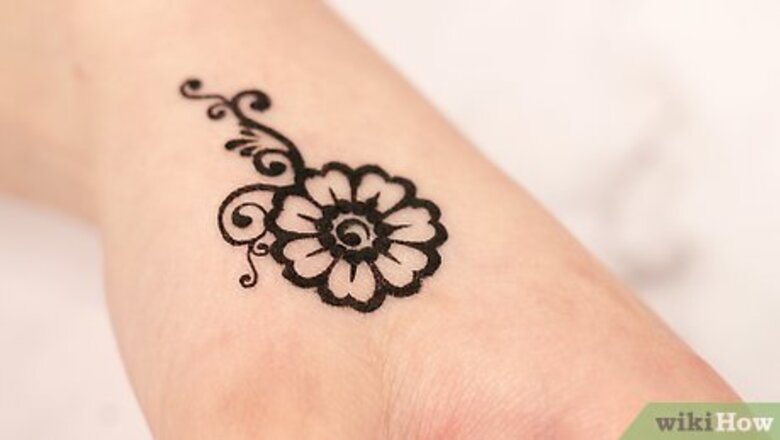
views
- Let the henna paste sit on your skin for 5-6 hours before removing it.
- Avoid getting your henna tattoo wet for 24 hours.
- Your henna design should last for 1-3 weeks. Keeping your tattoo moisturized will help it last longer.
Letting the Henna Set
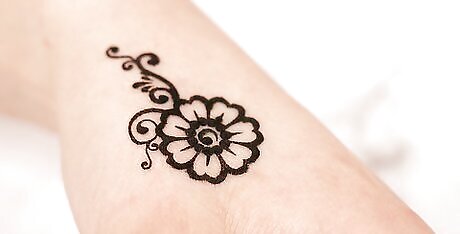
Let the paste dry for 30 minutes before touching it. Henna paste is moist when applied, and it’s best to keep your design away from any possible obstructions—hair, clothing, etc.—to avoid smudging. The paste typically dries on the surface in 5 to 10 minutes but takes up to 30 minutes to harden. Make sure to wash your skin with soap and water before applying your henna design, as any dirt or excess oils could result in a lighter stain.
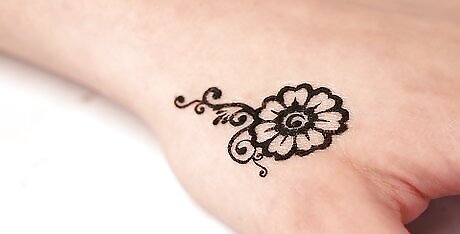
Leave the henna paste on your skin for as long as possible. The longer the paste stays on your skin, the darker the stain will be. Let the paste dry on your skin for 5 to 6 hours, or better yet, leave it on overnight. If you leave the henna paste on overnight, wrap it gently in gauze to avoid smudging it in your sleep.
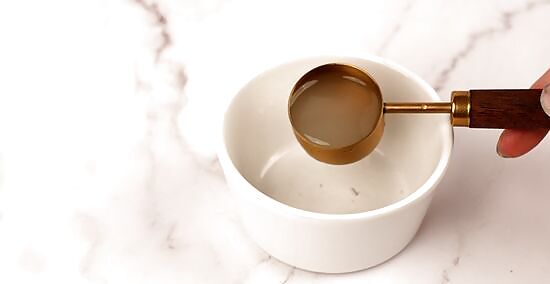
Dab sugar and lemon juice on the paste to darken the color. Fill a small bowl with 20 millilitres (0.085 c) of lemon juice, then mix in 1 tablespoon (0.062 c) of sugar until the solution is sticky and syrupy. Use a cotton ball to blot the mixture onto the dry henna. Leave the paste to soak for a few hours or overnight. This helps keep the henna paste moist longer, resulting in a darker stain. Be careful not to oversaturate the henna; only put on enough so it’s slightly damp. If you use too much, the dye may smear and drip. The ratios for the sugar and lemon mixture don’t have to be exact. Add more or less of each ingredient until the mix has a honey-like consistency. If you leave the solution on your skin overnight, wrap the design with gauze to prevent it from smearing.

Keep your skin warm to speed up the drying process. The warmer your body temperature, the faster the henna will stain. If you’re cold, drink a hot cup of tea or drape a heated blanket over your legs. Make sure the area you’re putting the henna design is warm before application. For instance, if you’re doing a henna tattoo on your hand, run your hands under warm water before drawing.

Wrap the design with a bandage or toilet paper to prevent flaking. The henna paste will flake and crumble as it dries, so consider covering the inked area. This will help lock in moisture and heat, making the stain even darker. Use an elastic bandage, paper medical tape, or toilet paper, and then cover the wrap with a sock for extra security. Try laying a piece of toilet paper over the design, then wrapping the area with an elastic bandage. If you’re using plastic wrap, wrap the design with toilet paper first to prevent smudges. Henna stains textiles like clothing, sheets, and towels, so wrapping the design can provide extra protection to keep your clothes and bedding stain-free. Some artists claim that wrapping is the only way to care for a henna design, while others believe you only need to wrap large, detailed designs.
Removing the Paste
Scrape off the henna paste gently after at least 5 to 6 hours. Use a clean, dull scraping tool, like a toothpick, a fingernail, a file, or the blunt side of a knife. Remember, no rubbing or scrubbing! When your skin is clean, pat it with a clean towel or cloth to remove any leftover flakes.
Keep the henna area away from soap and water for up to 24 hours. Try not to get the area wet for at least 6 to 12 hours after paste removal (although the effect will be stronger if you wait 24 hours). Water can upset your henna stain's oxidization and darkening process, so washing the area could make it fade.
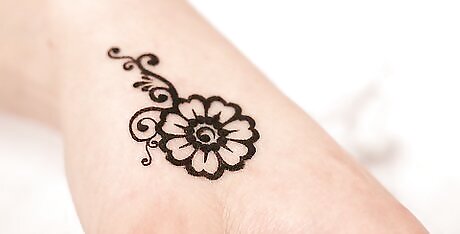
Watch the color deepen over the next 48 hours. Watch the ink mature after exposing your skin and scrapping off the dried henna paste. The design should look orange at first, ranging from a bright neon to the color of a pumpkin (if you’re using traditional henna). Then, over the next 48 hours, it’ll deepen into a rich, red-brown color with the final result being an orange-brown, maroon, or chocolate, depending on your skin tone. Henna designs are the darkest 1 or 2 days after the initial application and typically look darker on hands and feet.
Caring for the Design
Apply a coat of natural oil, butter, or lotion after removing the paste. Moisturizing your henna design regularly can help it last longer and prevent it from fading. Dab olive oil, coconut oil, or a chemical-free lotion over the design once a day. Stay away from moisturizers containing bleaching agents and fruit acids, like alpha-hydroxy acid, as these exfoliate the skin and can cause your henna to fade prematurely. Avoid using petroleum gels to moisturize your henna, as this can cause the stain to fade. Try using essential oils to moisturize your henna. Eucalyptus oil is a great choice, as it moisturizes and gives off a soothing scent. Consider purchasing a specific henna care oil if you get or make henna tattoos often.
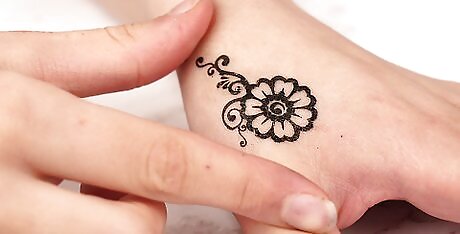
Avoid rubbing, picking at, or exfoliating your henna design. Exfoliation can fade henna, even after it’s dry. Skip using a washcloth to cleanse the design area, and try to wear clothing that doesn’t go over it. The less you touch the area, the better. If you have a hand henna tattoo, try wearing rubber gloves while doing the dishes.
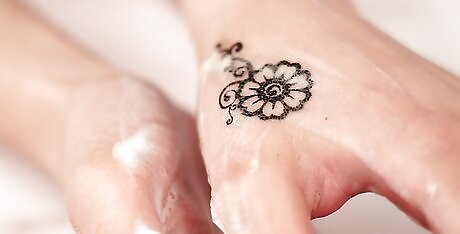
Clean your skin with a gentle soap and nothing else. Once the henna has been on your skin for 12 to 24 hours, using gentle soap on the design area is okay. Gentle soaps are typically marketed for “sensitive skin” or are “fragrance-free.” Some examples include Dove Sensitive Skin Bar and Cetaphil Cleansing Lotion. However, avoid cleaning with harsh soaps as much as possible. Harsh soaps are usually highly fragranced and antibacterial. Avoid products containing acetone, such as nail polish removers and hand sanitizers. These contain chemicals that can strip your skin of natural oils and make your tattoo fade quickly. Stay away from chlorine, salt water, and bleach, as these solutions can also cause your stain to fade faster.

Expect your henna design to last 1 to 3 weeks. The duration depends on how well you care for your skin and how often the design touches water. If you keep the stain moisturized and avoid rubbing it, the tattoo may last 3 weeks or longer. If you don't take extra measures to care for the henna, it’ll likely begin to fade or peel within the first week. A henna stain's longevity also depends on the design's location. For instance, a stain on your hand may fade faster than a stain on your back because you wash your hands more frequently.













Comments
0 comment